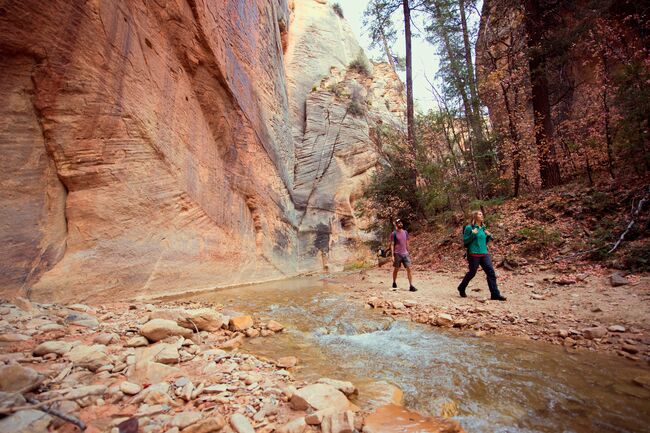
Zion’s Hop Valley Trail Officially Incorporated into the Park
Zion’s Hop Valley Trail Officially Incorporated into the Park
In the early 1860s, a handful of Mormon pioneers in Utah settled near the mouth of a deep, dark canyon carved by the Virgin River. The Paiute people who’d inhabited the area for generations called the canyon Mukuntuweap, which may have meant “straight canyon,” given its sheer walls. The Mormon settlers, once they’d explored its depths and experienced its beauty, named the canyon Zion: a biblical word meaning refuge and sanctuary. “Here we have natural temples,” a settler reportedly said of the sculpted sandstone cliffs that soared over his homestead.
 Zion is the third most popular national park in the country. Last year, more than 4 million people ventured to remote southern Utah to experience its canyons, waterfalls, and stunning desert vistas.Photo credit: Mike Schirf
Zion is the third most popular national park in the country. Last year, more than 4 million people ventured to remote southern Utah to experience its canyons, waterfalls, and stunning desert vistas.Photo credit: Mike Schirf
The canyon, and its tributaries and surrounding desert plateaus, would eventually be protected by the National Park Service. It’s now at the heart of the third most visited national park in the country, drawing more than 4 million people in 2017. Today, most visitors to Zion National Park arrive by car and shuttle instead of horseback and wagon—but the place still inspires the same reverence, awe, and wonder.
What many visitors don’t realize is that parts of this wild, beloved national park remain at risk of development. There are nearly 3,000 acres of unprotected land within the park’s boundaries. These islands of private property, or “inholdings,” can impact trail access, wildfire management, views, water quality, and wildlife habitat … not to mention interrupting your hike. Some landowners have built large homes on inholdings—not a welcome sight for hikers wandering along a remote trail through a desert wilderness.
That’s why we’re proud to announce today that we’ve protected a 35-acre inholding along the popular Hop Valley Trail within Zion National Park. We’ll donate the land to the National Park Service next month.
This project is just the latest in our history of protecting land within and around Zion. We’ve protected a total of 40 acres at the base of Tabernacle Dome, a spectacular peak in the park’s Kolob Terrace section. And in 2013, we protected Chamberlain Ranch. The ranch is outside the park’s boundary, but it contains a trailhead for the Zion Narrows Trail—a world-famous trek through a narrow slot canyon included on many a hiker’s bucket lists.
 It’s easy to see why the Zion Narrows Trail makes it onto many hikers’ bucket lists: the 16-mile route winds down an ever-deepening slot canyon. At points, the trail disappears and hikers must wade in the river itself .Photo credit: Mike Schirf
It’s easy to see why the Zion Narrows Trail makes it onto many hikers’ bucket lists: the 16-mile route winds down an ever-deepening slot canyon. At points, the trail disappears and hikers must wade in the river itself .Photo credit: Mike Schirf
Zion isn’t the only national park where inholdings threaten public access, habitat, and water quality. A recent report found that more than 9 million acres of public land across the West are “landlocked,” cut off from public access by private land. And in recent years, we’ve protected inholdings and “edgeholdings” at Yosemite, Glacier, Rocky Mountain, and Saguaro National Parks.
Do you agree that our national parks should be protected as everyone’s shared backyard? Let us know in the comments, or head over to Facebook to share why national parks matter to you.
This raw, beautiful landscape in Southern California is home to Indigenous heritage sites, and it provides critical habitat for threatened and endangered species. Urge President Biden to safeguard this extraordinary landscape today!


Donate to become a member, and you’ll receive a subscription to Land&People magazine, our biannual publication featuring exclusive, inspiring stories about our work connecting everyone to the outdoors.
See how our supporters are helping us connect people to the outdoors across the country.

